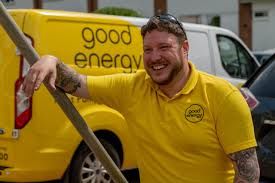
Domestic-scale solar generators share more of the power they generate with the grid than they use
London, June 10, 2024 , (Oilandgaspress) –Good Energy shows for the first time that domestic-scale solar generators share more of the power they generate with the grid than they use themselves. Introducing compulsory solar panels on the 1.5m new-build properties Labour has pledged to build within five years of forming a government would generate enough electricity to power an additional 1.17m homes through surplus energy shared back with the grid, according to new analysis1 from renewable energy company Good Energy.
If a typical 4kW solar array was installed on each new home, these homes would collectively generate 5.25 TWh2 – more than five per cent of the UK’s entire domestic electricity consumption in 2023. To give some Math and context, a 4kW solar array – the typical on an average house – multiplied (X) by 1.5m homes would generate 6GW – so over 10% of the target the Labour are aiming to achieve.Based on Good Energy’s findings, more than 3.1TWh of this power would be shared back to the grid.
A home with a 4kW solar array would save around £313 on their energy bill based on the latest price cap unit rate, and the export would be worth a further £315 based on the current 15p export rate – collectively earning households around £600 annually.
The calculations are based on new data from Good Energy, taken from smart meter readings from more than 900 domestic solar customers across the UK over more than 12 months. Believed to be the first study of its kind for the industry, it shows that the average UK home with solar panels on its roof shares an average of 60% of the electricity generated back to the grid for others to use.

Good Energy says the UK has been under-estimating the potential impact of small-scale solar generation, which could have a significant contribution to the UK’s energy mix with the implementation of relatively straightforward policies.
Data on the total electricity generation of UK homes has been available via manual meter readings, but robust industry data on the electricity exported by the average solar home is now available for the very first time thanks to Good Energy’s roll-out of smart export metering, which the company now provides to over 70,000 customers.
Houses with solar have been paid for the electricity they generate since 2004 when Good Energy created its HomeGen scheme, which became the blueprint for the government’s Feed-in-Tariff (FiT), launched in 2010. The FiT scheme offers a 50% export payment for non-smart metered generators, regardless of how much a solar household shares back with the grid or uses itself. This arbitrary figure was set when FiT originally launched, and was based on an assumption about how much power these microgenerators would use, which has likely increased since due to technology improvements increasing average install capacity.
The FiT closed to new registrants in 2019 and was replaced by the Smart Export Guarantee (SEG), however is still by far the largest scheme under which small scale solar generators can be paid for their power. Today, there remains over 870,000 FiT accredited generators in the UK with a total capacity of just under 6.5GW – about double the planned capacity of Hinkley Point C.
Nigel Pocklington, chief executive officer of Good Energy, said: “This study shows that small-scale solar’s contribution to cutting the country’s carbon has long been undervalued. There is a bias towards thinking only ‘big’ is beautiful in energy, and a lack of data from microgenerators hasn’t helped. But we’re looking to change that.
“Supporting people to generate their own clean power is a clear and economical way to achieving our climate targets as a country. Instigating a strong energy policy that is based on home-grown renewables should be a core priority for the incoming government, and measures such as mandating solar panels on new-build homes would be an important and highly effective component of that – as well as making a meaningful contribution to zero carbon power goals.”
Good Energy is calling for a range of measures to boost the contribution of small-scale solar generation, of which compulsory solar panels on new-build homes would be the top priority. A relatively straightforward route for mandating solar panels on new homes would be through the Government’s proposed Future Homes Standard, scheduled to apply from 2025. If implemented the mandate for solar would save homeowners bills and carbon emissions while enabling them and housing associations to sell surplus energy back to the grid.
It also says that incentivising retro-fits with grants and zero-interest loans, in line with Scotland which provides grants of up to £7,500 with an optional £7,500 loan offered interest-free on top, would open up solar possibilities to millions more households; and that archaic rules tethering customers to the same company for both electricity and export should be overturned to give customers freedom of choice and access to more competitive products.
Good Energy, which is the biggest voluntary FiT administrator, has invested in providing new services for small-scale generators, including smart export. Its new data shows a typical 4kW solar household would earn £120 more per year from the electricity they export through Good Energy’s smart 15p/kWh Solar Savings rate than they would through a FiT export payment, receiving payment for the actual amount of electricity exported rather than the 50% deemed amount under FiT.
Good Energy’s standalone smart export tariff for Feed-in-Tariff and non-Feed-in-Tariff accredited microgenerators alike, Solar Savings, pays 15p per kilowatt hour for exported power or 20p for customers who install their solar through Good Energy.
Four out of five FiT export payments (80%) in Ofgem’s most recent report were still at the deemed 50% level.
Information Source: Read More
Oil and gas press covers, Energy Monitor, Climate, Renewable, Wind, Biomass, Sustainability, Oil Price, LPG, Solar, Marine, Aviation, Fuel, Hydrogen, Electric ,EV, Gas,

